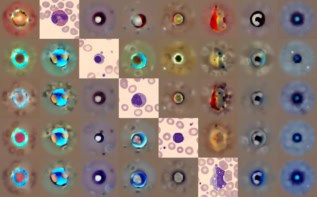
A new high-speed multifocus microscope could facilitate discoveries in developmental biology and neuroscience thanks to its ability to image rapid biological processes over the entire volume of tiny living organisms in real time.
The pictures from many 3D microscopes are obtained sequentially by scanning through different depths, making them too slow for accurate live imaging of fast-moving natural functions in individual cells and microscopic animals. Even current multifocus microscopes that capture 3D images simultaneously have either relatively poor image resolution or can only image to shallow depths.
In contrast, the new 25-camera “M25” microscope – developed during his doctorate by Eduardo Hirata-Miyasaki and his supervisor Sara Abrahamsson, both then at the University of California Santa Cruz, together with collaborators at the Marine Biological Laboratory in Massachusetts and the New Jersey Institute of Technology – enables high-resolution 3D imaging over a large field-of-view, with each camera capturing 180 × 180 × 50 µm volumes at a rate of 100 per second.
“Because the M25 microscope is geared towards advancing biomedical imaging we wanted to push the boundaries for speed, high resolution and looking at large volumes with a high signal-to-noise ratio,” says Hirata-Miyasaki, who is now based in the Chan Zuckerberg Biohub in San Francisco.
The M25, detailed in Optica, builds on previous diffractive-based multifocus microscopy work by Abrahamsson, explains Hirata-Miyasaki. In order to capture multiple focal planes simultaneously, the researchers devised a multifocus grating (MFG) for the M25. This diffraction grating splits the image beam coming from the microscope into a 5 × 5 grid of evenly illuminated 2D focal planes, each of which is recorded on one of the 25 synchronized machine vision cameras, such that every camera in the array captures a 3D volume focused on a different depth. To avoid blurred images, a custom-designed blazed grating in front of each camera lens corrects for the chromatic dispersion (which spreads out light of different wavelengths) introduced by the MFG.
The team used computer simulations to reveal the optimal designs for the diffractive optics, before creating them at the University of California Santa Barbara nanofabrication facility by etching nanometre-scale patterns into glass. To encourage widespread use of the M25, the researchers have published the fabrication recipes for their diffraction gratings and made the bespoke software for acquiring the microscope images open source. In addition, the M25 mounts to the side port of a standard microscope, and uses off-the-shelf cameras and camera lenses.
The M25 can image a range of biological systems, since it can be used for fluorescence microscopy – in which fluorescent dyes or proteins are used to tag structures or processes within cells – and can also work in transmission mode, in which light is shone through transparent samples. The latter allows small organisms like C. elegans larvae, which are commonly used for biological research, to be studied without disrupting them.
The researchers performed various imaging tests using the prototype M25, including observations of the natural swimming motion of entire C. elegans larvae. This ability to study cellular-level behaviour in microscopic organisms over their whole volume may pave the way for more detailed investigations into how the nervous system of C. elegans controls its movement, and how genetic mutations, diseases or medicinal drugs affect that behaviour, Hirata-Miyasaki tells Physics World. He adds that such studies could further our understanding of human neurodegenerative and neuromuscular diseases.
“We live in a 3D world that is also very dynamic. So with this microscope I really hope that we can keep pushing the boundaries of acquiring live volumetric information from small biological organisms, so that we can capture interactions between them and also [see] what is happening inside cells to help us understand the biology,” he continues.

Expansion microscopy enables nanoimaging with a conventional microscope
As part of his work at the Chan Zuckerberg Biohub, Hirata-Miyasaki is now developing deep-learning models for analysing dynamic cell and organism multichannel dynamic live datasets, like those acquired by the M25, “so that we can extract as much information as possible and learn from their dynamics”.
Meanwhile Abrahamsson, who is currently working in industry, hopes that other microscopy development labs will make their own M25 systems. She is also considering commercializing the instrument to help ensure its widespread use.



